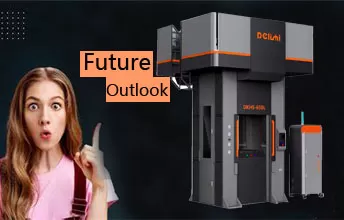1. Technological innovation and intelligence
Intelligent hydraulic presses: With the advancement of Industry 4.0, hydraulic presses will increasingly integrate sensors, Internet of Things (IoT) and artificial intelligence (AI) technologies to achieve remote monitoring, fault diagnosis and automatic control.
High-precision control: Through advanced hydraulic system and servo control technology, the hydraulic press will achieve higher precision and stability to meet the needs of precision manufacturing.
Modular design: In the future, hydraulic presses may adopt a modular design, which is convenient for rapid assembly, maintenance and upgrades, and reduces production costs.
2. Energy saving and environmental protection
Green hydraulic technology: develop low-energy, low-noise hydraulic systems to reduce energy consumption and environmental pollution.
Environmentally friendly hydraulic oil: Promote the use of biodegradable hydraulic oil to reduce environmental pollution.
Energy recovery system: Introduce energy recovery technology into the hydraulic press to store or reuse excess energy to improve energy efficiency.

3. Market demand and industry application
Emerging industry demand: With the rapid development of emerging industries such as new energy vehicles, aerospace, and 3D printing, hydraulic presses will play a greater role in the fields of new material molding and precision machining.
Customized solutions: customers' needs for hydraulic presses will be more diversified, promoting the development of the industry in the direction of customization and flexibility.
Global market expansion: With the acceleration of industrialization in developing countries, the hydraulic press market will further expand globally.
4. Material and manufacturing process upgrades
Lightweight design: Hydraulic presses are manufactured from high-strength, lightweight materials, such as composites, to reduce equipment weight and improve mobility and efficiency.
Advanced manufacturing technology: Introduce advanced manufacturing technologies such as 3D printing and laser processing to improve the performance and life of key components of hydraulic presses.
5. Industry competition and consolidation
Intensified technology competition: As technology advances, technology competition within the industry will become more intense, and companies need to continuously invest in R&D to remain competitive.
Accelerated industry consolidation: Small and medium-sized enterprises may integrate resources through mergers and acquisitions or cooperation, forming a more competitive industry structure.
6. Policies and Standards
Policy support: The support policies of various governments for manufacturing and environmental protection technology will bring new development opportunities to the hydraulic press industry.
Industry standardization: The design, manufacture, and operation of hydraulic presses will be more standardized to improve equipment compatibility and safety.
7. Talent training and skill upgrading
Training of technical talents: With the upgrading of hydraulic press technology, the industry's demand for high-skilled talents will continue to increase, promoting the development of relevant education and training.
Interdisciplinary collaboration: The hydraulic press industry will cooperate more with automation, materials science, information technology and other fields to promote interdisciplinary innovation.
Summary
The future of the hydraulic press industry will develop in the direction of intelligence, energy saving and customization, and at the same time find new growth points in emerging industries and global markets. Companies need to keep up with technology trends and focus on environmental protection and efficiency in order to have an edge in the future.


 +86-769-8306-1993
+86-769-8306-1993
 E-mail
E-mail
